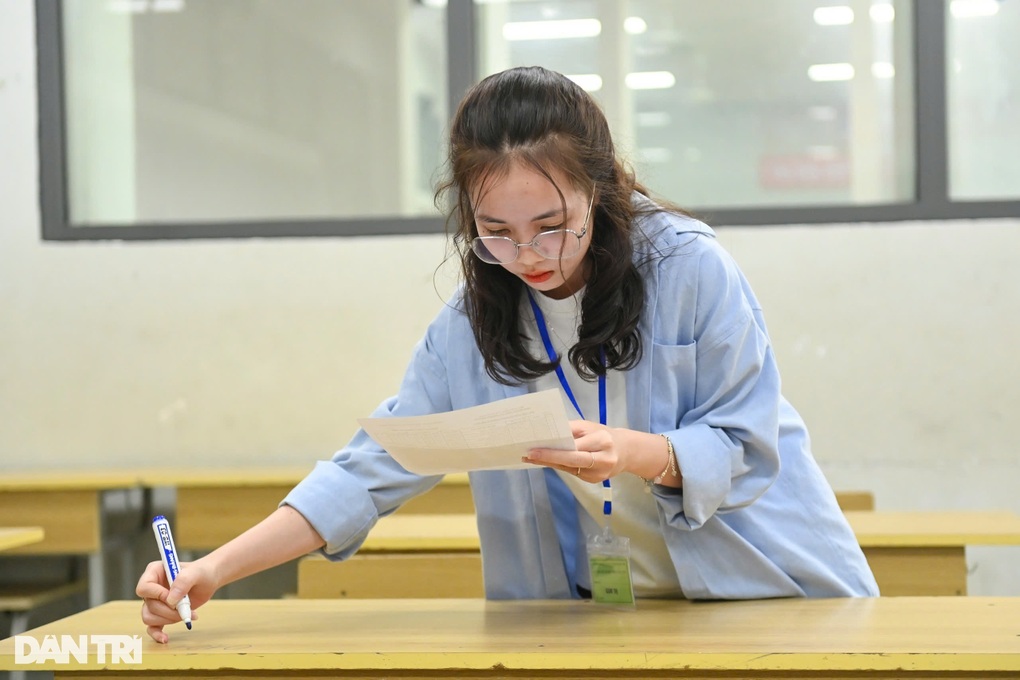Resolution 71 of the Politburo on breakthroughs in education and training development requires special and outstanding preferential policies for teachers.
Specifically, the preferential allowance for preschool and general education institutions will be increased to a minimum of 70% for teachers and 100% for teachers in particularly difficult areas, border areas, islands, and ethnic minority areas. School staff will receive a minimum allowance of 30%.
Previously, the draft Decree on preferential allowances according to professions in public educational institutions was announced by the Ministry of Education and Training for public consultation in June, stipulating an allowance of 30-80% for preschool and general education teachers.

Teachers work as invigilators at the high school graduation exam (Photo: Hai Long).
The 30% rate applies to junior high and high school teachers. In particular, junior high and high school teachers in communes in regions I and II, ethnic minority and mountainous areas, island communes, border communes, and safe zone communes according to Government regulations will receive a 35% allowance.
35% is also the rate applied to primary school teachers in general. Primary school teachers teaching in the above special areas have a 50% allowance.
45% and 60% are the two rates applied to preschool teachers. The higher rate is for preschool teachers in special areas.
Teachers teaching at ethnic boarding schools, specialized high schools, university preparatory schools, and schools for disabled students have an allowance of 70%.
The highest level of 80% is for teachers in communes in region III of ethnic minority and mountainous areas, island communes, and border communes.
Thus, compared to the above draft Decree, Resolution 71 requires a higher level of vocational allowance for teachers with the highest level reaching 100% of salary.
The Politburo also requires that spending on education and training reach at least 20% of total state budget expenditure, of which investment expenditure allocation reaches at least 5%, and spending on higher education reaches at least 3%.
The Politburo emphasized that education and training still face many difficulties and limitations and have not really become the key driving force for the country's breakthrough development. The teaching staff, facilities, and schools in many places do not meet requirements.
To make a breakthrough in education and training development, the Politburo determined that it is necessary to start with innovation in thinking, awareness and institutions, create a breakthrough in resources, motivation and new space, ensure the State plays a leading role, take public investment as the lead, and attract social resources for the comprehensive modernization of the national education system.
By 2045, Vietnam aims to have a modern, equitable and high-quality national education system, ranked among the top 20 countries in the world.
Source: https://dantri.com.vn/giao-duc/tang-phu-cap-cho-giao-vien-mam-non-pho-thong-len-toi-thieu-70-20250831081055051.htm



![[Photo] National Assembly Chairman Tran Thanh Man welcomes and holds talks with Chairman of the National People's Congress of China Zhao Leji](https://vphoto.vietnam.vn/thumb/1200x675/vietnam/resource/IMAGE/2025/8/31/9fa5b4d3f67d450682c03d35cabba711)

![[Photo] The first meeting of the Cooperation Committee between the National Assembly of Vietnam and the National People's Congress of China](https://vphoto.vietnam.vn/thumb/1200x675/vietnam/resource/IMAGE/2025/8/31/f5ed4def2e8f48e1a69b31464d355e12)

![[Photo] Marching together in the hearts of the people](https://vphoto.vietnam.vn/thumb/1200x675/vietnam/resource/IMAGE/2025/8/31/8b778f9202e54a60919734e6f1d938c3)
![[Photo] General Secretary To Lam receives Chairman of the National People's Congress of China Zhao Leji](https://vphoto.vietnam.vn/thumb/1200x675/vietnam/resource/IMAGE/2025/8/31/5af9b8d4ba2143348afe1c7ce6b7fa04)






















































































Comment (0)